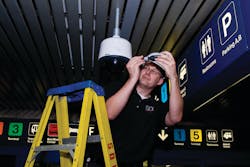Integrator Connection: Growth through Acquisition
System Development Integration LLC (SDI) of Chicago is on the fast-track to expansion. And the growth will continue. “The firm has set a financial growth goal of achieving $200 million in revenues by 2017,” company Founder and CEO David A. Gupta says. “SDI will achieve its growth goals by extending its target geographies, entering into new markets and adding new solutions and skill sets.”
With its two most recent acquisitions made in just the past couple of months, SDI has grown to a $70 million operation. Gupta’s goal of tripling size by 2017 is aggressive, but he says that SDI has “more than adequate financial capacity” to meet that objective. “These activities will happen both organically and via acquisition, and will be funded by our private equity investors LLR Partners,” Gupta says.
In early September, SDI acquired X7, a Washington, D.C.-based systems integrator — named the ninth-fastest growing systems integrator in Security Dealer & Integrator’s 2013 Fast50 awards, and was ranked No. 5 in 2012.
Earlier this June, SDI purchased i-sys, Corp., a systems integrator that focuses on integrated security, environmental and fire safety solutions. Its suite of clients includes major financial institutions, airports, seaports, state/local government, and universities from its offices in Sacramento, Calif.; Charleston, S.C.; and Knoxville, Tenn.
“Both firms had an attractive client list — especially adding large private-sector clients,” Gupta says. He notes there were several similarities in service offerings and an ability to cross-sell other SDI offerings such as network/infrastructure and enterprise apps. While they met the founders’ vision of growth, they also brought to the table proven ability to manage large, long-term contracts. “They have geographical locations that help expand our national footprint,” Gupta says. Just as important, there was a good “cultural fit” — something Gupta feels is important when bringing two companies together.
“Culture is something we proactively manage,” Gupta says. They expect exceptional delivery of services and that all members of the team will be there for the client. “Any candidate (for acquisition) will have to have that type of dedication,” Gupta adds. “There must be community involvement and mentoring of both their people and other firms.”
Not All Qualify
There are companies SDI has looked at that they decided not to acquire. “With the LLR Team, SDI had identified more than 50 potential candidates for acquisition activity that fit our initial profile,” Gupta says. He says the list was “down-selected” when organizations did not meet certain criteria. First on his list is what he calls “Culture Fit” — a meshing of professional services and client commitment.
They also were looking for firms that complemented existing SDI service offerings and would expand SDI’s geographical and/or client base.
Among the other factors were a need to find acquisitions with annual revenue greater or equal to $12 million, ability to maintain long-term contracts, a record of consistent revenue and profit growth over time, and demonstrated opportunities to sell additional services within the company’s existing client base.Even in a business as far-spread as the security integration field, it takes some doing to find potential acquisitions that meet all of those requirements and will help expand on SDI’s basic business direction.
Getting Started
SDI originated as the in-house technical staff within Environmental Systems Design, Inc. (ESD), an engineering firm in Chicago. In subsequent years, the information services division was sought after to provide standalone technology services to local governments, utility clients and businesses in the real estate, health care and finance industries.
On Nov. 22, 1996, the information services division emerged from the parent company as SDI (System Development Integration LLC) with a mission focused exclusively on providing information technology solutions and advisory services. “SDI has a core competency in successfully managing long-term contracts with our clients, delivering exceptional client care and value-add engineering/advisory services,” Gupta says.
Gupta himself worked for ESD in electrical systems engineering and information technology. He saw the pending big move to digital and IP for the security industry. “The business is more than hanging cameras,” he says. “It’s helping customers with workflow and how to manage their security environment.”
That environment becomes more dynamic every month. He actively avoided the conundrum some companies face in deciding whether to be a product provider or a true systems integrator. “A company has to go beyond construction to IT, managing change, managing the process,” Gupta says. “We are not a product provider. As an integrator we feel a need to be the best integrator offering IT management, consulting and change management.”
Making the Merger
To help assure a smooth and structured approach to the acquisition process, SDI put together a dedicated integration team that is responsible for implementing the company’s oft-tested integration plan. In advance of the close, the team identifies how best to combine personnel, functions and departments, along with a prioritized timeline for these areas once the acquisition was officially completed, Gupta explains.
Merging company cultures is not a one-way street and not an instant fix. Upon close of the acquisition, SDI immediately presents as much information as possible to all legacy and new employees as part of its system to move forward with important action items and fully integrate the two companies. The process has its roots back in June 2012 when SDI closed a private investment with private equity firms LLR Partners to fund the firm’s growth through acquisitions and expansion into commercial markets. That growth continues on the fast track.
“We don’t expect everything to happen overnight, but the key is to bring together the best of both worlds from the two companies, establishing universal practices and meshing the teams together,” Gupta says. “We are doing things ranging from establishing uniformity of HR policies and benefits to implementing sales best practices.”
What SDI Wants in a Partner
Gupta looks for partners with risk-mitigating technology delivery methodologies and SMEs in planning large-scale projects, specializing in areas like cut-overs, large data migrations, system/vendor transitions, etc. “Critical environment needs are different from typical organizations — from their broad range of highly complex legacy/hybrid/digital systems, to their elevated performance requirements, such as uptime, response time and high-capacity,” Gupta says, noting that SDI’s solutions are specifically geared for these environments.
Another key for a partner is having a single-source of technology accountability. “SDI acts as a cohesive leader to get to the final deliverable — we don’t walk away when it’s a product or other vendor’s problem,” Gupta says.
He sees SDI as a client advocate that delivers tailored solutions, shunning the cookie cutter one-size-fits-all product approach. “SDI provides a management consulting philosophy about addressing the client’s problems at the most detailed level,” he says. He expects his people to “hone in to the problem, pivot on the details and no stock answers.”
SDI doesn’t walk away if client needs extend beyond product standards. “We have the technical depth to go down to the code level and configure apps/hardware to meet a client’s specific needs,” Gupta says proudly. The company relies on its access to a robust vendor network to get the job done.
Of course, SDI is not the only security firm on an aggressive growth and acquisition path. What if someone were to pursue an acquisition of SDI? “We have an objective to build the company to a certain size,” Gupta says. “This would not be the right time.”
Meanwhile, SDI continues to strive to leverage its expertise in critical infrastructure environments and their unique requirements. Gupta points to their exceptional past and current performance in long-term service programs, offering technical capabilities of a global systems integrator within an agile, responsive partner.
SDI is proud to be vendor independent. Lastly, Gupta says they never would backfill with a “B Team” — that simply would not be in keeping with the company culture. “Our client’s best interests are our only interests,” Gupta says.
SDI at a Glance
Company name: SDI (System Development Integration LLC)
Website: www.sdienterprises.com
HQ location: Chicago, IL
Principal: David A. Gupta, founder and CEO
Year founded: 1996
Number of employees: 250
Residential/Commercial split: 99% commercial, 1% residential
Top technology brands deployed: Verint, Honeywell, Intergraph
Curt Harler is a technology writer and regular contributor to SD&I magazine. Reach him at [email protected].




